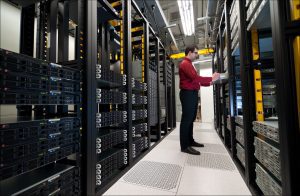If your data center energy bill is a bit higher than you’d like, you are certainly not alone. By their nature, data centers consume a lot of energy and there’s no reason to expect demand to do anything but grow.
I recently wrote a story on the topic for Energy Manager Today, a daily trade publication about energy management news. In the course of researching the piece, I came with some rather startling numbers. Consider:
- In 2010, data centers accounted for 1.3 percent of total global energy usage, according to Jonathan Toomey, a Ph.D. and professor on the environmental effects of information technology.
- That same year, data centers accounted for 2 percent of the nation’s total electricity usage. Think about that. Of all the buildings that exist in the U.S., certainly two out of every 100 are not data centers, yet they consume that percentage of electricity.
- IDC estimates the volume of digital content last year grew to 2.7 zettabytes (ZB), up 48 percent from 2011. Handling that kind of growth is only going to increase the demand for data centers and their associated energy costs.
From my experience as the Director of Energy Management Services for Schneider Electric, the companies that have the best results with energy efficiency efforts are those that make it a priority on a company-wide level. That means they have commitment and a champion from among the top of the executive management chain, those individuals who have a wide organizational view and can link together the IT strategy, utility budget and mission statement. When there’s a mandate to reduce consumption, facility managers are then free to formalize a plan, create a budget, partner with various providers, and generally get energy saving projects done.
As noted in the Energy Manager Today piece, there’s no single blueprint for an energy efficiency project that will work universally across all data centers. But there are a number of basic steps you can take that will address about 80 percent of the energy waste in a data center. Here are four for starters.
1. Virtualize and consolidate
Consolidating various applications onto fewer servers has a major impact on energy efficiency by reducing both server energy consumption and cooling requirements. The result is energy savings of 10 to 40 percent.
Virtualization will likewise lower energy usage but, as we’ve covered previously, it may actually cause an increase in Power Usage Effectiveness (PUE). You’ll need to optimize your power and cooling systems to get them in line with your new, lighter load in order to keep your PUE from rising.
2. Use a containment system
Many data centers routinely mix hot and cold air – effectively limiting the capacity and effectiveness of the cooling system. You can easily fix this by placing air tiles in the cold aisle, and/or locating supply vents in the cold aisle and return vents in the hot aisle, along with a curtain or hard enclosure to contain the cold or hot aisle. Not only does this make the cooling more productive, it also raises return temperatures, allowing your CRAC units to operate more efficiently.
3. Rethink temperature and humidity set points
Many data centers are too cold and dry, flying in the face of the latest ASHRAE recommendations. In 2008 ASHRAE adjusted its guidance around supply air temperatures to 64.4°F at the lowest extreme and 80.6°F at the high end, up from its previous recommended high of 77°F. Many data centers had been setting temperatures much lower, as low as 55°F. By simply raising the temperature even one degree, data centers can realize energy savings. The same goes for humidity, for which ASHRAE has also loosened its guidelines, bumping the high end to 60% relative humidity, up from 55% in 2004. It’s worth it to become well versed in the ASHRAE guidance (PDF) and adjust your temperature and humidity set points accordingly. With new server technology, we may even see additional increases on both settings.
4. Automation and Variable Frequency Drives
Variable frequency drives (VFDs) improve the energy efficiency of cooling equipment by enabling the systems to run at only a percentage of the motor speed, to more closely match the cooling supply to the necessary load. This results in less power used and limits over-cooling in the facility. Automation systems give managers the ability to integrate, control and monitor various aspects of the facility including HVAC, security, lighting, fire and other systems in one centralized application. Together, automation controls and VFDs provide a comprehensive method of controlling and adjusting different data center functions, making energy efficiency a priority. In some test cases, results have documented as much as a 66% reduction in cooling energy.
For more on the topic, check out the full Energy Manager Today article.



Conversation
Lance,
Excellent article. Very useful information.
Thank you,
Daniel Beney